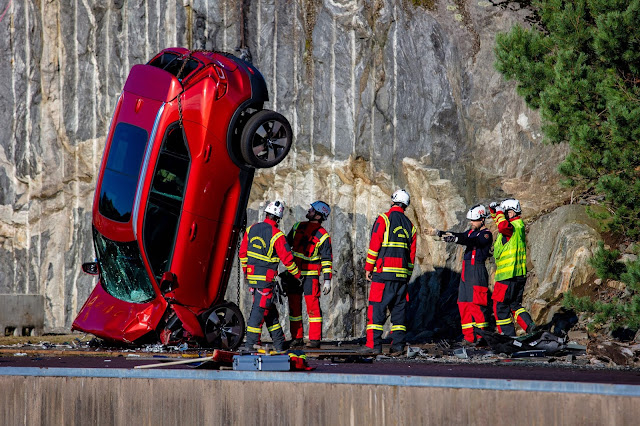Volvo Cars drop new cars from 30 metres
Usually, rescue workers get their training vehicles from scrapyards but these cars are often up to two decades old so there is a huge difference between modern cars and those built fifteen to twenty years ago, writes Trish Whelan.
To allow rescue services to prepare for any possible crash scenario and to simulate the forces that erupt in the most extreme crashes, beyond what can be simulated with ordinary crash testing, Volvo Cars recently took equally extreme measures, dropping several new Volvos multiple times from a crane, from a height of 30 metres.
A total of ten Volvos, of different models, were dropped from the crane several times. Before the drop, the company’s safety engineers made exact calculations about how much pressure and force each car needed to be exposed to in order to reach the desired level of damage.
Dropping cars from such a height created enough damage to adequately simulate the damage found in the most extreme crash scenarios such as single-car accidents at very high speed, accidents where a car hits a truck at high speed, or accidents whereby a ca takes a severe hit from the side. In such situations, people inside the car are likely to be in a critical condition so the priority is to get people out of the car and to a hospital as quickly as possible using hydraulic rescue tools. They need to release and get a patient to the hospital within one hour after the accident has occurred.
Volvo have been working closely with the Swedish rescue services for many years. Hakan Gustafson, a senior investigator with the Volvo Cars Traffic Accident Research Team says they have the same goal: to have safer roads for all. “It is vital there are methods to help save lives when the most severe accidents happen.” All findings from the crashes and the resulting extrication work will be collected and the report made available free of use to rescue workers elsewhere so they can further develop their life-saving capabilities.
This year, Volvo Cars Safety Centre crash lab celebrated its 20th anniversary. Their commitment to safety is about finding out how and why accidents and injuries occur and then developing the technology to help prevent them. Cars at the Centre can be crashed at speeds up to 120km/h.







Comments
Post a Comment